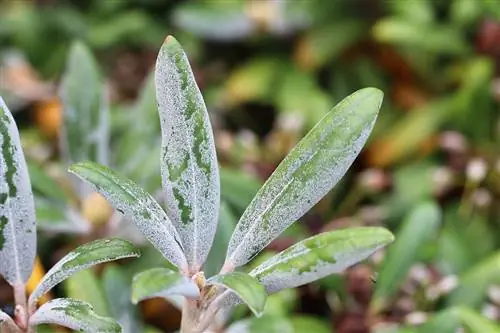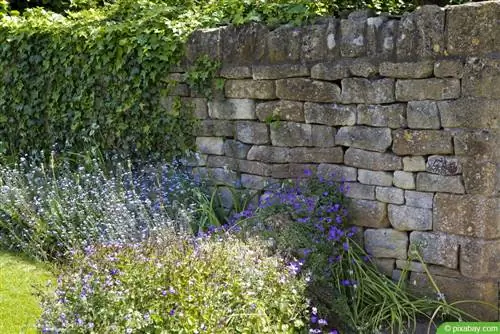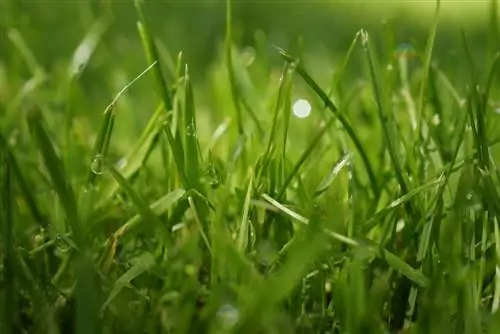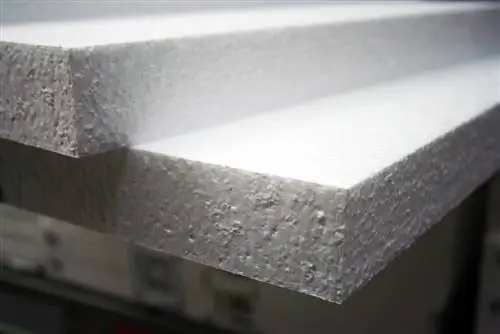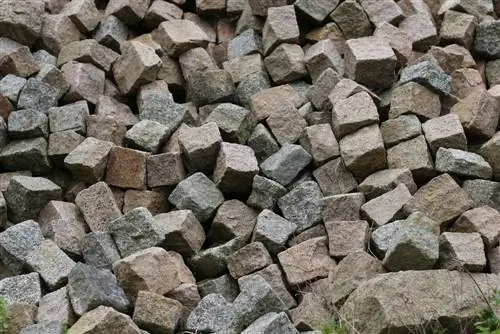- Author admin [email protected].
- Public 2023-12-17 03:39.
- Last modified 2025-01-24 12:45.
If mold stains appear on the walls, the feel-good atmosphere is usually gone. They look unsightly, make rooms appear unkempt and are reminiscent of he alth-threatening mold infestation. But no one has to live with the brownish, sometimes yellowish discolorations, because they can be easily removed using home remedies.
Mold stains are distinguished from mold infestation
If there are dark discolorations on walls, the first step to removal is to identify them precisely. Mildew stains are often confused with mold, which requires a different removal method. Although they are both generally closely related to moisture, they can be distinguished from one another based on several characteristics.
Recognize
At first glance and by smell, mildew and mold are usually impossible to tell apart. Even preferred wall locations such as corners, behind cupboards, on window frames or in the bathroom do not provide any information as to whether there is mold or mildew.
Finger test
If it is mold, you should wear gloves for your own safety when taking a finger sample. Run your finger over the stain. If it goes away, you are usually dealing with mold. A fox stain, on the other hand, appears as a fixed point on the surface. This is due to the fact that a mildew stain forms in the subsurface structure in “stagnant” moist air conditions when moisture becomes trapped. Mold, on the other hand, mainly develops on the surface of damp surfaces and then “eats” through wallpaper and moves on.
While mildew is limited purely to a damp area, mold can spread further from one point. During reproduction, so-called mycelia are formed in the advanced stage. This is a braid that feels like a soft cotton carpet and consists of thread cells. Each mold spot has a defined border.
Causes
“Stock air conditions”
It has not yet been possible to research what causes mildew stains. It is known that they accumulate where there is high humidity or unusually high ambient humidity. If this remains enclosed, i.e. there is no or insufficient air exchange, the dark, usually point-shaped mold spots form. On walls this is often behind pictures, closets and carpets or washing machines. Stains also often occur in damp rooms, such as the bathroom, if doors and windows are always closed after a hot bath. Experts refer to this as an air exclusion or inclusion. If the air humidity is “locked in”, this offers the best conditions for the stains.
Folding as a symptom
Fold stains cannot always be avoided by ensuring good room ventilation. If there is damage that extends into the walls and causes permanent dampness, it cannot be counteracted even with window openings and heat as long as the cause has not been remedied.
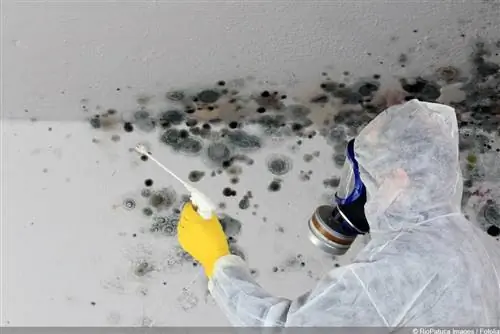
Fold stains can be a sign that there is inadequate wall insulation and that moisture is evenly drawn into the walls from outside. In new buildings, mold stains often occur when wallpaper is still wet. The moisture in the plaster cannot escape through wallpaper and various types of paint. The foxing begins. They can also be a symptom of broken water pipes. In any case, the cause must be remedied, because no home remedy, no matter how good it may be, can prevent the rapid formation of new mold stains as long as the moisture problem is not solved.
Removal of mildew stains
Plaster/Concrete
Do-it-yourself stores offer numerous chemical products for removing mildew stains, such as products containing chlorine. Application on colored wallpaper is difficult or even unsuitable. For this reason, such chemicals can only be used for these stains on plaster or white surfaces. In the latter case, it is advisable to take a sample in an invisible place, as chlorine can cause yellow spots. These are harder to remove than mildew stains and, in the worst case, cannot be covered by painting again. Normal home remedies are better. However, chlorine treatment is recommended for interior plastering and house walls. You can easily make the chlorine mixture yourself:
- Fill bucket three quarters full with hot water
- Put on protective gloves and breathing mask now at the latest
- Add a generous dose of chlorine (for example Domestos)
- Mix the mixture well
- Use a sponge to wet the affected areas with the chlorine solution and rub in
- If the stains do not come off on the first try, repeat the process
- Afterwards, rinse the treated area with plenty of clean water
- If necessary, wipe with vinegar water afterwards, this neutralizes the pungent smell of chlorine
Tip:
After chemical treatment, ventilation must always be ensured so that harmful gases can escape from the room.
Paintable wallpapers
According to current scientific knowledge, mold stains are not a he alth hazard like mold is. For this reason, the focus when it comes to distance is on “not being able to see”. The easiest trick is to paint over them when they or the surface has dried. Highly opaque paints, such as an insulating emulsion paint, are ideal for mildew stains on woodchip and paper wallpaper.
Textile wallpapers
If mold stains appear on textile wallpaper, they cannot be removed with paint and purchasing new ones is expensive and laborious. Using glass or vinegar cleaner helps here. Glass cleaner is better suited for larger areas as vinegar dissolves wallpaper paste.
Proceed as follows for treatment:
- Spray glass cleaner onto the mold stains (approx. two sprays per spray area)
- Let it work for around 5 minutes
- Spray stains again
- Rub firmly over the stains with a microfiber cloth
- Repeat if necessary
- Wood paneling
If mold stains have formed in/on wall paneling, they are usually deep because wood completely absorbs moisture. Action should be taken immediately the first time the spots are spotted. With mold-ex products it is possible to successfully remove light stains. If this doesn't help, the only option is to use a sander.
Tip:
Basically, the floor in the area of the affected wall areas should be covered before any treatment. Many home remedies have a liquid consistency and can cause color changes or damage to the floor.
More home remedies for removing mildew stains
Baking powder
Baking powder has a slightly bleaching effect, which is why it is advisable to first test the treatment on an invisible area for colored surfaces. If the infestation is severe, baking soda can reduce the intensity. Less stubborn mildew stains can usually be removed completely.
To treat mildew, proceed as follows:
- Moisturize affected areas well
- Let baking powder trickle from top to bottom over the moistened areas (it sticks)
- Depending on the robustness of the surface, rub with a cloth or a nail brush
- Remove residue with a damp cloth
Soda
Above-average results can be achieved with a mixture of baking soda and citric acid. Here 50 grams of baking soda powder and 50 grams of citric acid powder are mixed with 150 milliliters of water. The application is as follows:
- Apply solution to the wall with a cloth, sponge or brush
- Leave for half an hour
- Wipe up any wet residue with a damp cloth
- Put a little washing powder in a bucket of water
- Wash treated areas
- Follow up with clear water
Buttermilk
Buttermilk can help effectively remove mildew stains from textile and paper wallpaper. The application follows these instructions:
- Spread buttermilk on the stains
- Let it absorb for at least 15 minutes
- Rub with a wallpaper brush
- Another five minutes of exposure time
- Remove remaining buttermilk with a damp cloth/sponge
- Proceed thoroughly as leftover buttermilk can cause a bad smell
Spirit
If you ventilate the rooms well after the treatment, you can use alcohol to get rid of mold stains.
- Make a mixture of spirit and water in a ratio of 1:1
- Rubbing mildew stains with it
- Let it soak in for around ten minutes
- Wipe with a damp cloth
Tip:
If a lot of water is used on a wall, it must be ensured that it dries quickly. Warm heating air or special drying devices accelerate drying and prevent renewed mold stains.
Preventing mildew stains
Reduce humidity

In order to prevent new infestations, you should keep an eye on the air and room humidity. Dehumidifiers are particularly suitable in humid spring and autumn months when the heating hardly ensures drier conditions.
ventilate
Regular ventilation is a must to enable air exchange. The rule here is to ventilate briefly, but several times a day.
Observe
Pay attention to changes on the walls that are typical of moisture in masonry, such as yellowish discoloration, peeling wallpaper or the formation of water droplets. There could be water damage here that is causing mildew stains. A quick repair prevents stains.
Air circulation
If a shelf, a cupboard or a tumble dryer that is closed at the back closes directly to the wall, no air can circulate here. There is an air pocket that promotes mildew. Maintain at least one to two centimeters of distance from the wall.


